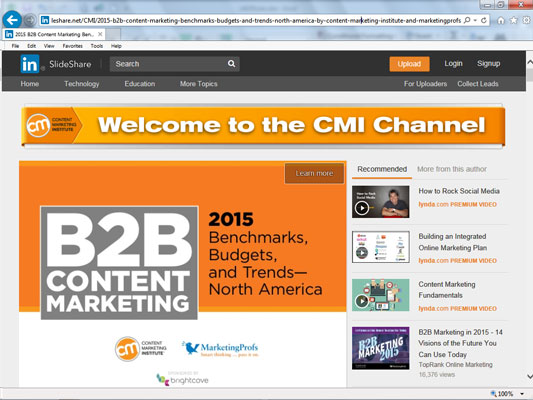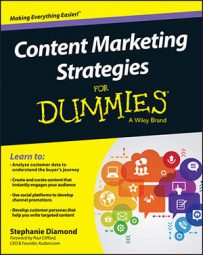Uncovering your content marketing goals
When looking at formulating your own goals, it can be useful to see what other marketers set as their top goals for B2B content marketing. According to the “2015 Benchmarks, Budgets and Trends — North America” report by the Content Marketing Institute/Marketing Profs, (see the following figure), the top organizational goals for B2B content marketing are the following:-
Brand awareness: 84 percent
-
Lead generation: 83 percent
-
Engagement: 81 percent
-
Sales: 75 percent
-
Lead nurturing: 74 percent
-
Customer Retention/Loyalty: 69 percent
-
Customer Evangelism: 57 percent
-
Upsell/Cross-sell: 52 percent
 2015 Benchmarks, Budgets, and Trends — North America Survey.
2015 Benchmarks, Budgets, and Trends — North America Survey.
Picking KPIs
After you establish your goals, you need to develop Key Performance Indicators (KPIs). KPIs are the measures you choose to help you determine whether you’re reaching your business goals. You need them to keep your strategy on track. If you don’t measure yourself against your business goals, you won’t know whether your content marketing strategy is working and supporting your larger business goals.To help you think about how to craft your KPIs in relation to your marketing goals, check out the table. You can apply the table to your marketing plan as well. List your goals and then choose some metrics. Then refer back to this list when you check your progress.
| CMI/Marketing Profs B2B Top Goals | Suggested Metrics |
|---|---|
| Increase brand awareness | Social media shares, social media likes, email forwards, referral links |
| Lead generation Lead nurturing | Blog signups, blog comments, conversion rate, form completions |
| Increase engagement | Comments, page depth (how many pages consumed), downloads, page views, back links, time on site, click through rate |
| Grow sales revenue by X percent | Revenue influenced by content (which content was consumed before sale), offline sales |
| Improve customer retention/loyalty | Bounce rate, followers, retention rate |
| Encourage customer evangelism | Social media shares, comments, follower count, word of mouth |
| Increase upsells/cross-sells | Measure conversions in shopping cart and on landing pages, number of conversions |

